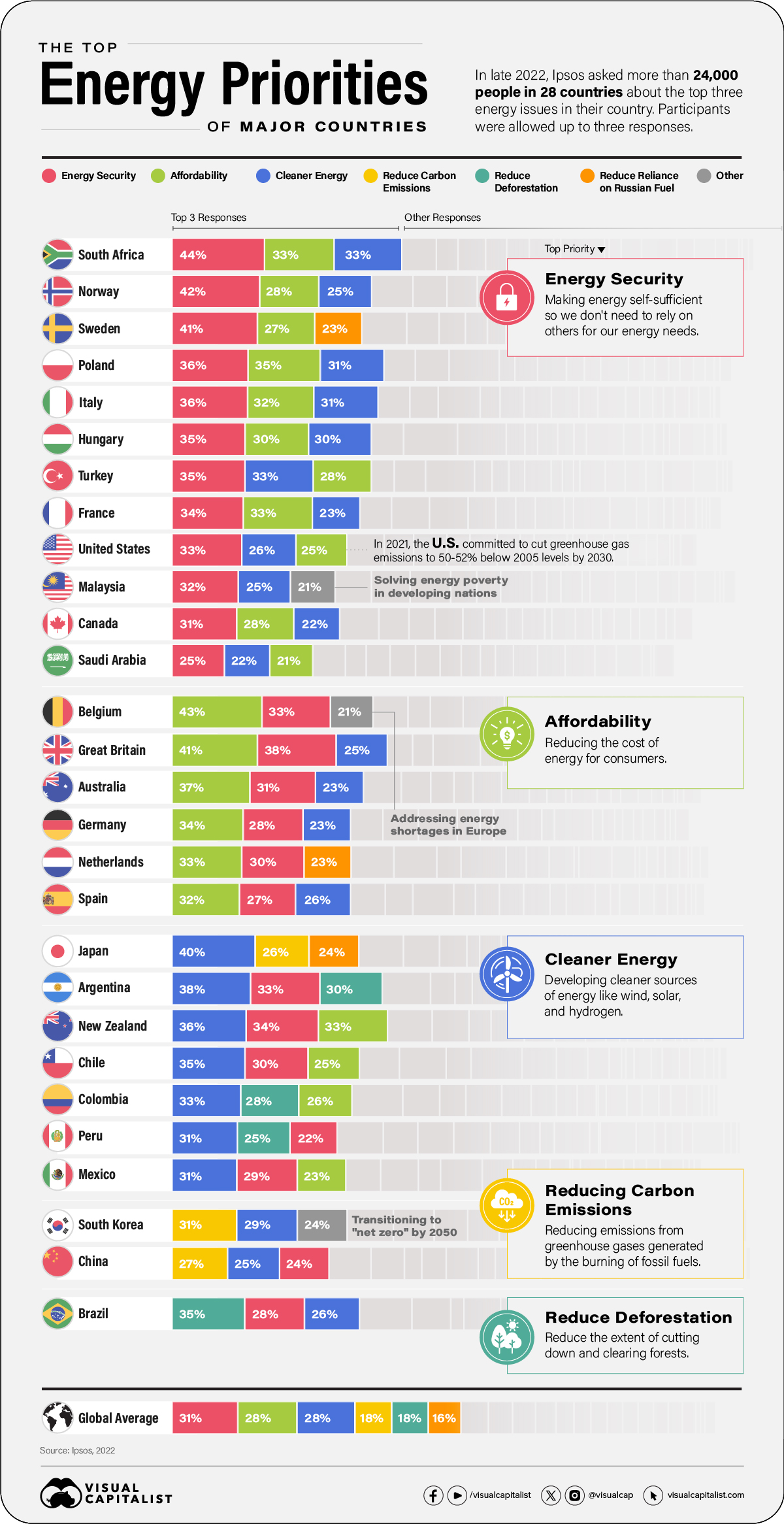Energy
Visualizing the Top Energy Priorities of Major Countries

Visualizing the Top Energy Priorities of Major Countries
As policy makers, business leaders, and academics gather at COP28 in Dubai this week, topics like climate change and the energy transition will be front and center.
Discussions and policy commitments on these issues are crucial. However, navigating the complexity of aligning policies for the future of energy can be challenging, given the multitude of sometimes conflicting priorities among nations.
Today’s visualization uses data from Ipsos, which details how 24,000 people in 28 countries feel about the top energy issues in their country.
Top Issue: Energy Security
The invasion of Ukraine by Russia has propelled energy security to the forefront of concerns for many countries, particularly in Europe.
Directly impacted nations, including Germany, have had to reactivate coal production and extend the operational lives of nuclear power plants to ensure adequate heating during winter.
According to the Ipsos survey, achieving energy self-sufficiency, thereby reducing dependence on external sources, is the top energy priority for numerous countries, including the U.S., Canada, Italy, and France.
| Country / Top Priority | Energy Security | Affordability | Cleaner Energy | Other |
|---|---|---|---|---|
| 🇿🇦 South Africa | 44% | 33% | 33% | 21% |
| 🇳🇴 Norway | 42% | 28% | 25% | 20% |
| 🇸🇪 Sweden | 41% | 27% | 21% | 23% |
| 🇵🇱 Poland | 36% | 35% | 31% | 24% |
| 🇮🇹 Italy | 36% | 32% | 31% | 20% |
| 🇭🇺 Hungary | 35% | 30% | 30% | 26% |
| 🇹🇷 Turkey | 35% | 28% | 33% | 23% |
| 🇫🇷 France | 34% | 33% | 23% | 18% |
| 🇺🇸 U.S. | 33% | 25% | 26% | 18% |
| 🇲🇾 Malaysia | 32% | 17% | 25% | 21% |
| 🇨🇦 Canada | 31% | 28% | 22% | 19% |
| 🇸🇦 Saudi Arabia | 25% | 21% | 22% | 16% |
The survey reveals that even countries self-reliant on energy consider energy security the top priority.
Norway, for example, gets 96% of its energy by exploiting its offshore oil and gas fields and using hydroelectric power. The country even has a surplus of power, which it exports to other countries, such as the UK. Despite this, self-sufficiency remains a top priority in the minds of Norwegians.
Top Issue: Cleaner Energy
Following energy security, the second most critical priority is the development of cleaner energy sources like wind, solar, and hydrogen.
| Country / Top Priority | Energy Security | Affordability | Cleaner Energy | Other |
|---|---|---|---|---|
| 🇯🇵 Japan | 21% | 17% | 40% | 26% |
| 🇦🇷 Argentina | 33% | 23% | 38% | 30% |
| 🇳🇿 New Zealand | 34% | 33% | 36% | 21% |
| 🇨🇱 Chile | 30% | 25% | 35% | 24% |
| 🇨🇴 Colombia | 24% | 26% | 33% | 28% |
| 🇵🇪 Peru | 22% | 22% | 31% | 25% |
| 🇲🇽 Mexico | 29% | 23% | 31% | 20% |
This concern is the top pick in Japan and a high concern for other Asian economies such as South Korea and China. Today, the region accounts for 52% of global carbon dioxide emissions.
Besides the environmental impact, clean energy development can have an economic impact. Recent studies have shown that doubling the share of renewables in the global energy mix could increase global GDP by up to 1.1% or $1.3 trillion.
Top Issue: Affordability of Energy
Reducing the cost of energy for consumers is the third most frequently mentioned concern. This is particularly emphasized in Belgium, Great Britain, and Germany, where prices are about double that of neighbors like France and Greece.
| Country / Top Priority | Energy Security | Affordability | Cleaner Energy | Other |
|---|---|---|---|---|
| 🇧🇪 Belgium | 33% | 43% | 17% | 21% |
| 🇬🇧 Great Britain | 38% | 41% | 25% | 24% |
| 🇦🇺 Australia | 31% | 37% | 23% | 18% |
| 🇩🇪 Germany | 28% | 34% | 23% | 15% |
| 🇳🇱 Netherlands | 30% | 33% | 20% | 23% |
| 🇪🇸 Spain | 27% | 32% | 26% | 20% |
For perspective, energy prices in many European countries are more than twice or three times the global average.
Less frequently mentioned energy priorities include:
- Building more energy infrastructure.
- Charging energy consumers more taxes for excessive use.
- Ensuring Indigenous peoples benefit from major energy projects.
Reducing deforestation emerged as the top priority in Brazil, home to 60% of the Amazon rainforest. Recent data indicates that almost 20% of the forest has been destroyed since the 1970s.
Energy
Charted: 4 Reasons Why Lithium Could Be the Next Gold Rush
Visual Capitalist has partnered with EnergyX to show why drops in prices and growing demand may make now the right time to invest in lithium.

4 Reasons Why You Should Invest in Lithium
Lithium’s importance in powering EVs makes it a linchpin of the clean energy transition and one of the world’s most precious minerals.
In this graphic, Visual Capitalist partnered with EnergyX to explore why now may be the time to invest in lithium.
1. Lithium Prices Have Dropped
One of the most critical aspects of evaluating an investment is ensuring that the asset’s value is higher than its price would indicate. Lithium is integral to powering EVs, and, prices have fallen fast over the last year:
| Date | LiOH·H₂O* | Li₂CO₃** |
|---|---|---|
| Feb 2023 | $76 | $71 |
| March 2023 | $71 | $61 |
| Apr 2023 | $43 | $33 |
| May 2023 | $43 | $33 |
| June 2023 | $47 | $45 |
| July 2023 | $44 | $40 |
| Aug 2023 | $35 | $35 |
| Sept 2023 | $28 | $27 |
| Oct 2023 | $24 | $23 |
| Nov 2023 | $21 | $21 |
| Dec 2023 | $17 | $16 |
| Jan 2024 | $14 | $15 |
| Feb 2024 | $13 | $14 |
Note: Monthly spot prices were taken as close to the 14th of each month as possible.
*Lithium hydroxide monohydrate MB-LI-0033
**Lithium carbonate MB-LI-0029
2. Lithium-Ion Battery Prices Are Also Falling
The drop in lithium prices is just one reason to invest in the metal. Increasing economies of scale, coupled with low commodity prices, have caused the cost of lithium-ion batteries to drop significantly as well.
In fact, BNEF reports that between 2013 and 2023, the price of a Li-ion battery dropped by 82%.
| Year | Price per KWh |
|---|---|
| 2023 | $139 |
| 2022 | $161 |
| 2021 | $150 |
| 2020 | $160 |
| 2019 | $183 |
| 2018 | $211 |
| 2017 | $258 |
| 2016 | $345 |
| 2015 | $448 |
| 2014 | $692 |
| 2013 | $780 |

3. EV Adoption is Sustainable
One of the best reasons to invest in lithium is that EVs, one of the main drivers behind the demand for lithium, have reached a price point similar to that of traditional vehicle.
According to the Kelly Blue Book, Tesla’s average transaction price dropped by 25% between 2022 and 2023, bringing it in line with many other major manufacturers and showing that EVs are a realistic transport option from a consumer price perspective.
| Manufacturer | September 2022 | September 2023 |
|---|---|---|
| BMW | $69,000 | $72,000 |
| Ford | $54,000 | $56,000 |
| Volkswagon | $54,000 | $56,000 |
| General Motors | $52,000 | $53,000 |
| Tesla | $68,000 | $51,000 |
4. Electricity Demand in Transport is Growing
As EVs become an accessible transport option, there’s an investment opportunity in lithium. But possibly the best reason to invest in lithium is that the IEA reports global demand for the electricity in transport could grow dramatically by 2030:
| Transport Type | 2022 | 2025 | 2030 |
|---|---|---|---|
| Buses 🚌 | 23,000 GWh | 50,000 GWh | 130,000 GWh |
| Cars 🚙 | 65,000 GWh | 200,000 GWh | 570,000 GWh |
| Trucks 🛻 | 4,000 GWh | 15,000 GWh | 94,000 GWh |
| Vans 🚐 | 6,000 GWh | 16,000 GWh | 72,000 GWh |
The Lithium Investment Opportunity
Lithium presents a potentially classic investment opportunity. Lithium and battery prices have dropped significantly, and recently, EVs have reached a price point similar to other vehicles. By 2030, the demand for clean energy, especially in transport, will grow dramatically.
With prices dropping and demand skyrocketing, now is the time to invest in lithium.
EnergyX is poised to exploit lithium demand with cutting-edge lithium extraction technology capable of extracting 300% more lithium than current processes.

-

 Lithium5 days ago
Lithium5 days agoRanked: The Top 10 EV Battery Manufacturers in 2023
Asia dominates this ranking of the world’s largest EV battery manufacturers in 2023.
-

 Energy1 week ago
Energy1 week agoThe World’s Biggest Nuclear Energy Producers
China has grown its nuclear capacity over the last decade, now ranking second on the list of top nuclear energy producers.
-

 Energy1 month ago
Energy1 month agoThe World’s Biggest Oil Producers in 2023
Just three countries accounted for 40% of global oil production last year.
-

 Energy1 month ago
Energy1 month agoHow Much Does the U.S. Depend on Russian Uranium?
Currently, Russia is the largest foreign supplier of nuclear power fuel to the U.S.
-

 Uranium2 months ago
Uranium2 months agoCharted: Global Uranium Reserves, by Country
We visualize the distribution of the world’s uranium reserves by country, with 3 countries accounting for more than half of total reserves.
-

 Energy3 months ago
Energy3 months agoVisualizing the Rise of the U.S. as Top Crude Oil Producer
Over the last decade, the United States has established itself as the world’s top producer of crude oil, surpassing Saudi Arabia and Russia.
-

 Science1 week ago
Science1 week agoVisualizing the Average Lifespans of Mammals
-

 Demographics2 weeks ago
Demographics2 weeks agoThe Smallest Gender Wage Gaps in OECD Countries
-

 United States2 weeks ago
United States2 weeks agoWhere U.S. Inflation Hit the Hardest in March 2024
-

 Green2 weeks ago
Green2 weeks agoTop Countries By Forest Growth Since 2001
-

 United States2 weeks ago
United States2 weeks agoRanked: The Largest U.S. Corporations by Number of Employees
-

 Maps2 weeks ago
Maps2 weeks agoThe Largest Earthquakes in the New York Area (1970-2024)
-

 Green2 weeks ago
Green2 weeks agoRanked: The Countries With the Most Air Pollution in 2023
-

 Green2 weeks ago
Green2 weeks agoRanking the Top 15 Countries by Carbon Tax Revenue









